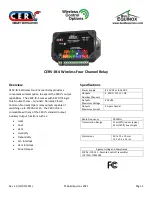
RNPP-301
2. DESCRIPTION
1
2
The RNPP-301 relay (hereafter “the relay”) is a digital microprocessor device that provides a high degree of
reliability and accuracy. The relay doesn’t require any auxiliary power supply because it is self-powered by the
three-phase voltage to be monitored. This permits the relay to keep operate capability even when only one
phase is present (in the three-phase systems with neutral). Two modes of the mains voltage monitoring can
be selected at the user’s option:
The line voltage monitoring mode
.
To go into this mode of operation one needs to apply the jumper strap between terminals 8-9; in this case to
connect the neutral is not necessary. This mode of operation is recommended when the neutral drift value and
phase voltage imbalance is not important as well as for isolated neutral three-phase systems. The relay will
trip when line voltage imbalance between phases occurs.
Note
:To keep the relay operative and informative when only one phase is present it’s advisable to connect the
neutral to the terminal 7 not removing the jumper strap between terminals
8-9.
In 3-Phase systems without
neutral the relay keeps operational capability when at least two phases are present.
The relay is connected in parallel to load by the
L1, L2, L3
input contacts (the
4, 5, 6
terminals respectively).
The neutral connection mode
(N, the 7 terminal)
corresponds to the mains voltage monitoring mode of
operation selected by user. The
1, 2, 3
terminals provide the MS power contacts status monitoring and are
connected to the output MS power contacts terminals (see the wiring diagram). The relay has two groups of
independent output contacts
(10-11, 12-13)
. In the “dead status” of the relay (a voltage is not applied to the
relay, the relay is not connected) the
12-13
are the
N.O.
contacts and the
10-11
are
N.C.
contacts. After the
relay has been connected in parallel to load when voltage is present in the mains and there is no cause for the
relay to trip, the
12-13
contacts are being closed and the
10-11
contacts are being opened with the user-set
reset delay Ton.
It is recommended the
12-13
contacts to connect in series with the MS coil power supply.
When the relay tripped, load is de-energized due to the break in the MS coil power curcuit by the
N. O. 12-13
contacts
THE 10-11, 12-13 OUTPUT CONTACTS SPECIFICATION
Max. current for
~ 250 V A. C.
Max. power
Max sustained
safe voltage ~
Max. current for
U = 30V D.C.
Cosφ = 0.4
3A
Cosφ = 1.0
5A
2000VA
460V
3V
One of the relay functions is the monitoring of the MS power contacts position before load energization and
after load is energized. The monitoring is performed if the1, 2, 3 terminals are connected to the corresponding
phases of the MS output contacts. The monitoring is performed as follows:
Before load is energized a test for open position of all three MS power contacts is performed. If at least
•
one contact is closed (“sticks”) the relay will be disabled, the load is not energized, all red “FAULT” LEDs
are ON. To enable the relay one needs to remove supply voltage from it. It’s recommended to test the MS
running order, following safety regulations.
When load is energized, the test for closed position of all three MS power contacts is performed. If at least
•
one MS phase contact is open, the relay will trip to de-energize load and will be disabled. All red “FAULT”
LEDs are ON. To enable the relay one needs to remove supply voltage from it. It’s recommended to test
the MS running order, following safety regulations.
MS POWER CONTACTS TRANSFER MONITORING























